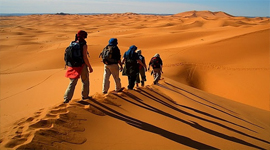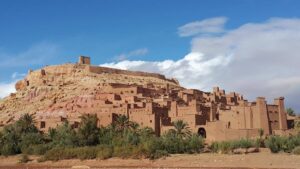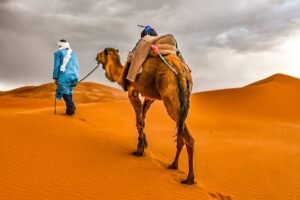
Marrakech To M’hamid Desert Tour 2 days
Marrakech To M’hamid Desert Tour 2 days Overview:
Day 1: The journey begins with a scenic drive through the majestic High Atlas Mountains, revealing authentic Berber villages and the ancient Ait Benhaddou, a UNESCO-listed clay Kasbah rich in history. Passing through Ouarzazate, often called the “Hollywood of Africa,” the tour continues along the picturesque Draa Valley, home to Morocco’s longest river and vast palm groves. Discover the historic towns of Agdz and Zagora before embarking on a camel ride to the mesmerizing sand dunes of M’hamid. Spend the night in a traditional Berber camp under the starlit desert sky.
Day 2: Visit Tamegroute, a significant religious center known for its ancient Quranic library and distinctive green pottery. The journey concludes with a return to Marrakech, traveling through the stunning Draa Valley and over the High Atlas Mountains once more.
This immersive experience captures the essence of Morocco’s breathtaking landscapes, vibrant culture, and rich history.
• Tizi-n-Tichka Pass: Scenic drive through the breathtaking High Atlas Mountains, passing through authentic Berber villages.
• Ait Benhaddou: Explore the UNESCO-listed ancient fortified city, famous for its stunning clay Kasbahs.
• Ouarzazate – The Hollywood of Africa: Visit renowned film locations and studios in this iconic movie-making city.
• Draa Valley: Journey along Morocco’s longest river, discovering lush palm groves and traditional Draa Valley communities.
• Agdz and Zagora: Explore Agdz and the historic town of Zagora, once a resting place on the ancient caravan route, with its impressive fortress.
• Sand Dunes of M’Hamid: Enjoy a camel ride and a magical sunset experience in the vast desert.
• Tamegroute: Visit the significant religious center, home to an ancient Sufi zawiya and famous for its unique green pottery.
• Tamnougalt Kasbah: Discover this historic kasbah situated along the Draa River Valley.
• Return via High Atlas Mountains: Conclude the journey with a scenic drive back to Marrakech through the majestic mountain landscapes.
• Cultural Immersion: Interact with locals, savor traditional Moroccan tea, and learn about the region’s rich cultural heritage and history.
Itinerary
Day 1 : Marrakesh – Ait Ben Haddou – Ouarzazate – Agdz – Zagora –Sand dunes of M’Hamid (470km)
 Marrakech to M’hamid desert tour 2 days /1 night via Zagora Draa Valley . After breakfast, we start our trip throughout Tizi-n-Tichka pass of the High Atlas Mountains. Where hundreds superb authentic Berber villages scattered on the mountains. Unexpectedly you will see a fascinating presence of hundreds of houses in Berber villages which are made from mud and straw; in the middle of nowhere; thousands of satellite dishes on roofs. All this make you feel that nothing has been changed in life here through thousands of years. Meanwhile, donkeys and mules are still the main means of transportation among these high and tough mountains since there are no accesses for cars and tracks. After almost three hours driving, we will stop to visit the ancient fortified city of Ait Benhaddou which was first built in the 11th century and has been listed by the UNESCO in 1992 as a world heritage site. Explore the streets of this clay Kasbah at a relaxed pace and have some tea with the family that still living there looking after the Kasbah. Here more than 300 families used to live, and each Berber family consists of at least ten people. So you would imagine how many families used to live here! More than 3000. We pass by Ouarzazate (Hollywood of Africa, Noiselessly Town, the door of the desert), is a city is situated in the middle of a bare plateau, South of the High Atlas Mountains. Why is this town nicknamed as Hollywood of Africa? Simply because it has been noted as a film-making location, with Morocco’s biggest studios inviting many international film companies to shoot their movies, like: Lawrence of Arabia (1962), The Living Daylights (1987), The Last Temptation of Christ (1988), The Mummy (1999), Gladiator (2000), Kingdom of Heaven (2005), Martin Scorsese’s Kundun (1997) and Babel (2005). We drive along Draa valley ,which is Morocco’s longest river (1100 km). The water from this river is used to irrigate one of the biggest palm groves of the kingdom. The inhabitants of the Draa are called Drawa. Outside of the Draa region, this name is mostly used to refer to the dark skinned people of Draa which make up the largest portion of its inhabitants, 225,000 people live in the valley of the Draa, which measures 23,000 km.
Marrakech to M’hamid desert tour 2 days /1 night via Zagora Draa Valley . After breakfast, we start our trip throughout Tizi-n-Tichka pass of the High Atlas Mountains. Where hundreds superb authentic Berber villages scattered on the mountains. Unexpectedly you will see a fascinating presence of hundreds of houses in Berber villages which are made from mud and straw; in the middle of nowhere; thousands of satellite dishes on roofs. All this make you feel that nothing has been changed in life here through thousands of years. Meanwhile, donkeys and mules are still the main means of transportation among these high and tough mountains since there are no accesses for cars and tracks. After almost three hours driving, we will stop to visit the ancient fortified city of Ait Benhaddou which was first built in the 11th century and has been listed by the UNESCO in 1992 as a world heritage site. Explore the streets of this clay Kasbah at a relaxed pace and have some tea with the family that still living there looking after the Kasbah. Here more than 300 families used to live, and each Berber family consists of at least ten people. So you would imagine how many families used to live here! More than 3000. We pass by Ouarzazate (Hollywood of Africa, Noiselessly Town, the door of the desert), is a city is situated in the middle of a bare plateau, South of the High Atlas Mountains. Why is this town nicknamed as Hollywood of Africa? Simply because it has been noted as a film-making location, with Morocco’s biggest studios inviting many international film companies to shoot their movies, like: Lawrence of Arabia (1962), The Living Daylights (1987), The Last Temptation of Christ (1988), The Mummy (1999), Gladiator (2000), Kingdom of Heaven (2005), Martin Scorsese’s Kundun (1997) and Babel (2005). We drive along Draa valley ,which is Morocco’s longest river (1100 km). The water from this river is used to irrigate one of the biggest palm groves of the kingdom. The inhabitants of the Draa are called Drawa. Outside of the Draa region, this name is mostly used to refer to the dark skinned people of Draa which make up the largest portion of its inhabitants, 225,000 people live in the valley of the Draa, which measures 23,000 km.

Arriving Agdz, which is located about 65 km from Ouarzazate, Agdz means “resting place,” is located on the old caravan route linking Marrakech to Timbuktu. Agdz long played an important economic role. Then, because of the drought years of 1970/1980 and lack of facilities of transportation, it has lost its importance, leading too much of the population to leave town in search of work. We arrive to Zagora, which is a town in the valley of the Draa River. It is flanked by the mountain Zagora from which the town got its name. On the top of the Zagora Mountain the remains of an Almoravid fortress can still be seen. The exact location of the former Almoravid mosque is still a matter of dispute. Each year the moussem (festival) of the Sufi saint Moulay Abd-el-Kader Jilali is celebrated at Zagora. A well-known sign at the town “Tombouctou 52 days”, the supposed time it takes to get to Timbuktu, Mali on foot or camel. From Zagora to M’hamid, which is a very modest village and not much different from the village you have passed before arriving here. From a vast plateau, you will get impressed by the huge sand dune, where we go for a camel ride to meet one of the most fascinating sand dunes sights we will ever see, the superb sunset in the middle of the high sand dune. Tonight we stay in Berber camp and enjoy a wonderful stars view.
Day 2: Sand dunes of M’Hamid – Tamegroute–Zagora – Ouarzazate – Marrakech

After breakfast our drive will be to Tamegroute, which is a religious center since the 11th century It has a history as an important center of learning and religion through its famous Sufi zawiya, historical center of the Nasiriyya Sufi order, one of the most influential – and at one time one of the largest – Sufi orders in the Islamic world. Tamegroute’s green pottery is also very well-known. The founders of the religious brotherhood Nasiriyya wanted to raise the status of the village of Tamegroute to that of a “Medina”, that is to say to make it a city. They assembled the merchants and craftsmen that they had brought from Fes, a city that enjoyed good relations with Tamegroute at the time. Today Tamegroute is a little village, but the pottery has become its main characteristic and the ancient techniques give the glaze infinite variations. We drive back along the valley of the Draa River, we go back centuries by visiting Tamnougalt Kasbah, it is situated on Draa River valley, some 95 km south of Ouarzazate. In berber Tamnougalt means ‘meeting point’ was possibly a garrison in the Saadian dynasty. The Glaoua where to play a big role in the Draa region.In the twenties of the 20th century relations between the Glaoua and the Mezguita became more and more strained because of the struggle for the power over the Draa. For this purpose, T’hami El Glaoui held a war to Tamnougalt in 1919. We keep driving to Ouarzazate and drive back to Marrakesh through the High Atlas mountains. The end of the Marrakech to M’hamid 2 days Desert Tour.
Included
- Pick-Up & Drop-Off At Your Hotel Or Airport
- Transport In A Private 4×4 Car Or Minibus With A/C
- Fuel And Anythings Linked To The Car And Driver
- 1 Night In The Camp & Hotel
- Camel Rides To Reach The Desert Camp In Merzouga Sahara Desert
- Dinners And Breakfasts.
- Multilingual Driver/Guide
Not Included
- Personal Purchases
- Drinks
- Lunch
- Tips

